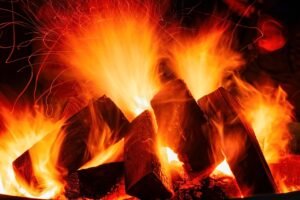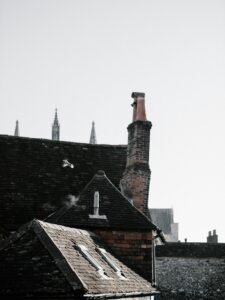Here in Oxfordshire, a crackling fireplace is a focal point of many a cosy winter evening. But for optimal safety and enjoyment, keeping your chimney clean is essential. Regular chimney sweeps remove creosote build-ups and ensure proper ventilation, preventing chimney fires and other hazards. At First Choice Chimney Sweeps, we recommend annual inspections, but how do you know when it’s time for a sweep in between? Here are 5 signs your Oxfordshire fireplace is calling for professional attention:
1. Smoke Backups Filling Your Home
This is a major red flag. Smoke billowing back into your living room indicates a blockage in the flue, likely caused by creosote build-up or debris like animal nests. Not only is smoky ambience unpleasant, but it can also be dangerous, potentially leading to carbon monoxide poisoning.
2. Difficulty Maintaining a Fire
Does your fire struggle to catch or stay lit? A clogged chimney restricts airflow, hindering proper burning. A professional sweep can remove obstructions and restore optimal airflow for a roaring fire.
3. Excessive Soot and Creosote Build-up
Notice flakes of black soot around your fireplace opening, or even inside the flue if visible? This is a telltale sign of creosote build-up. Creosote is highly flammable, and excessive accumulation significantly increases the risk of chimney fires.
4. Strange Odours Coming From the Chimney
A chimney shouldn’t emit unpleasant smells, even when not in use. A foul odour, especially a burning or chemical scent, often indicates creosote build-up or trapped animals within the flue.
5. Unusual Sounds During Use
Does your chimney crackle, pop, or hiss more than usual when burning a fire? These noises can signify loose bricks, gaps in the flue liner, or debris lodged within the chimney. A professional sweep can identify and address the source of these sounds.
First Choice Chimney Sweeps: Keeping Oxfordshire Homes Safe and Warm
Don’t wait for a major problem to arise. By recognizing these signs and scheduling regular chimney sweeps with First Choice Chimney Sweeps, you can ensure the safety and efficiency of your Oxfordshire fireplace for years to come.
Contact us today at 01865 747 454 or email us at sales@firstchoicechimneysweeps.co.uk to schedule your chimney sweep and enjoy a worry-free winter with a warm, inviting fireplace.






